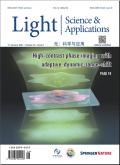激光发射振动显微镜微滴阵列高通量筛选高脂血症。
IF 23.4
Q1 OPTICS
引用次数: 0
摘要
生物流体的力学特性是疾病的早期指标,为复杂的生理和病理过程提供了有价值的见解。然而,现有技术难以实现高通量测量,限制了它们在疾病诊断中的广泛应用。在这里,我们提出了微液滴的激光发射振动显微镜,用于高通量测量流体的内在力学特性。采用喷墨打印技术在超疏水表面上大规模制备了支持高q因子(104)低语通道模式(WGM)激光的微滴阵列。利用超声驱动微液滴的机械振动,并利用时间分辨激光光谱对微液滴的振动幅度进行量化。我们发现激光发射的刺激响应强烈地依赖于液体粘度。通过分级扫描实现了微滴粘度的快速映射。通过在25分钟内进行超过2000次测量,也证明了高脂血症疾病的高通量筛选。由于微液滴体积小,一滴血可以支持700多万次测量。高通量和小样本消耗使其成为基于力学性能的临床诊断的有前途的工具。本文章由计算机程序翻译,如有差异,请以英文原文为准。
Laser-emission vibrational microscopy of microdroplet arrays for high-throughput screening of hyperlipidemia.
The mechanical properties of biological fluids serve as early indicators of disease, offering valuable insights into complex physiological and pathological processes. However, the existing technologies struggle to achieve high-throughput measurement, limiting their widespread applications in disease diagnosis. Here, we propose laser-emission vibrational microscopy of microdroplets for high-throughput measurement of the intrinsic mechanical properties of fluids. The microdroplet array supporting high Q-factor (104) whispering gallery modes (WGM) lasing was massively fabricated on a superhydrophobic surface with inkjet printing. Ultrasound was employed to actuate the mechanical vibrations of the microdroplets, and the vibration amplitude was quantified using time-resolved laser spectra. We found that the stimulus-response of the laser emission is strongly dependent on the liquid viscosity. Fast mapping of the microdroplets' viscosities was achieved by stage scanning. High-throughput screening of hyperlipidemia disease was also demonstrated by performing over 2000 measurements within 25 min. Thanks to the small volume of the microdroplets, a single drop of blood can support over seven million measurements. The high-throughput ability and small sample consumption make it a promising tool for clinical diagnoses based on mechanical properties.
求助全文
通过发布文献求助,成功后即可免费获取论文全文。
去求助
来源期刊

Light-Science & Applications
数理科学, 物理学I, 光学, 凝聚态物性 II :电子结构、电学、磁学和光学性质, 无机非金属材料, 无机非金属类光电信息与功能材料, 工程与材料, 信息科学, 光学和光电子学, 光学和光电子材料, 非线性光学与量子光学
自引率
0.00%
发文量
803
审稿时长
2.1 months
 求助内容:
求助内容: 应助结果提醒方式:
应助结果提醒方式:


